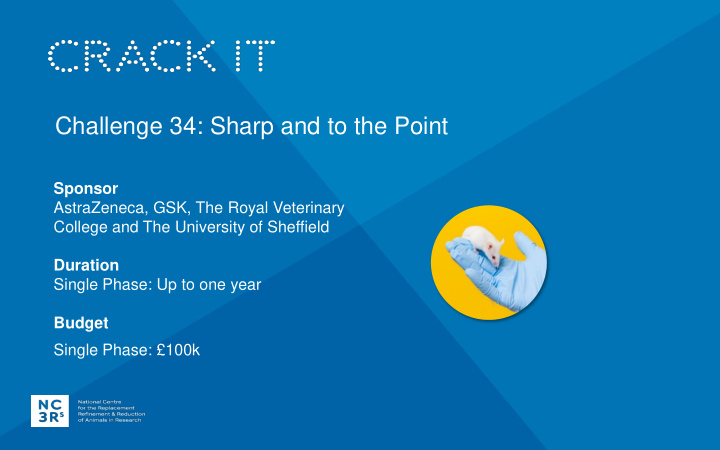



Challenge 34: Sharp and to the Point Sponsor AstraZeneca, GSK, The Royal Veterinary College and The University of Sheffield Duration Single Phase: Up to one year Budget Single Phase: £100k
Sharp and to the point : developing needles for high throughput and critical compound administration in mice. Sponsors: AstraZeneca, GlaxoSmithKline, The Royal Veterinary College London, University of Sheffield Launch Meeting 11 September 2019
The Challenge To develop a device that: Enables injections without losing material to dead space. ✓ ✓ Allows needles to be changed quickly and safely between animals to ensure sharpness and sterility. ✓ Prevents cross-contamination between animals. This must be competitively priced to facilitate broad uptake across the bioscience sector.
Why was this challenge developed? Background • In 2018, 1.8 million animals were used in experimental procedures in the UK.. Approximately 60% were mice. • Many of the mice used would have been injected with substances or sampled for blood collection using hypodermic needles. Most hypodermic needles used in animals are designed and sold as single- • use disposable needles. • Needles are reused for a number of reasons often to avoid loss of valuable material, and in some cases to reduce time and cost when using large numbers of animals.
Needle Reuse: Loss of Valuable Material to Dead Space Dead Space Fluid not expelled due to dead space • with between the syringe and the needle Standard leading to loss of material Needle/Syrin • Volumes administered to mice in ge particular are small, material lost to dead combination space can form a significant percentage of the material needed • Materials used in pilot studies are often Examples difficult and expensive to synthesise and are therefore made in small quantities. • Some studies involve the injection of living cells for example, for xenograft mouse models used in oncology research. Having sufficient numbers of viable cells is critical. Loss to dead space can be an issue for certain cell lines.
Needle Reuse: Time Taken to Change a Needle Between each Injections Using a new • Currently needles need to be changed manually between needle for each animal. This takes more time than reusing needles. each animal Examples • Materials may need to be injected within a limited time into large numbers of animals. For example, changing the needle for each animal in a study where the formulation stability requires all animals to be dosed within an hour of formulation preparation may require additional staff to complete the injections within the necessary timeframe.
Why is there a need? Animal Welfare Concerns • Re-use of needles results in a loss of sterility and can increase the risk of infection and disease transmission • Re-use also risks dulling of the needle, potentially increasing the pain and discomfort associated with subsequent injections • The discomfort felt by the animal may not be obvious enough to be noticed, for example background noise may hide transient vocalisation, and a good restraint will reduce the ability of the rodent to struggle. A small refinement would potentially impact a large number of animals.
Why is there a need? Other concerns Scientific Staff wellbeing • Confounding and • Pressure on some staff to unnecessary variables which reuse a needle will be can impact the quality of removed. scientific data collected. Public Expectations • 2018 MORI Poll The findings of the report indicate that animal welfare is becoming a bigger consideration for many of us
Current state of the art Low dead space needles and syringes are available but….. • They are not available in all needle gauges. • Syringe barrels are often difficult to read for small volumes which can affect the accuracy of small volume draws. Insulin syringes have been developed that have no dead space. However, • these are supplied with the needle attached making them inappropriate for use with substances that cannot be drawn up through the needle (e.g. cells).
Deliverables - essential A product that can be used to administer substances parenterally to mice and have the following features: Needles of suitable quality and sharpness The device must be able to for a single injection via various routes e.g. accurately deliver small intravenous, subcutaneous, intramuscular, volumes, typically 0.05 to 0.2mL intraperitoneal The device must be able to The product must be available deliver substances with minimal with a minimum of three needle loss due to dead space gauges in the range 23 to 29G Researchers must be able to rapidly, safely and easily change needles
Deliverables - Desirable The cost should be comparable to the • cu The cost should be comparable to the current costs of standard disposable needles and syringes. • standard disposable needles and syringes. An option to have a reservoir allowing a set volume to be Adaptable for other species delivered to large numbers of mice
What we don’t want A needle that can be reused as doesn’t address contamination issues A product that is complicated to use
Sponsor in-kind The Sponsors will provide: • Insight into needle usage across a diverse range of settings and applications. • Expertise and guidance in needle design and compound administration. • The opportunity to deploy and test the developed product(s) in both industry and academic settings and across different areas including: • Oncology Vaccines • Basic research • • Veterinary medicine
Thank you
Recommend
More recommend